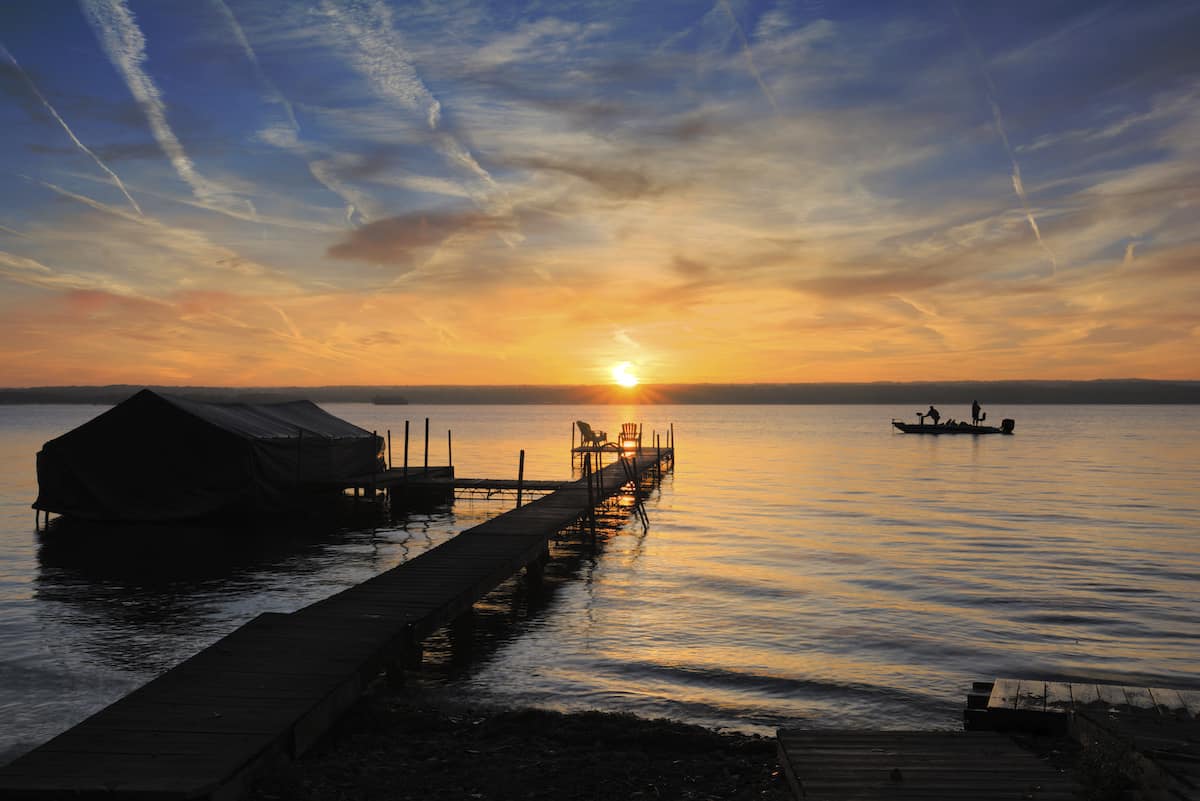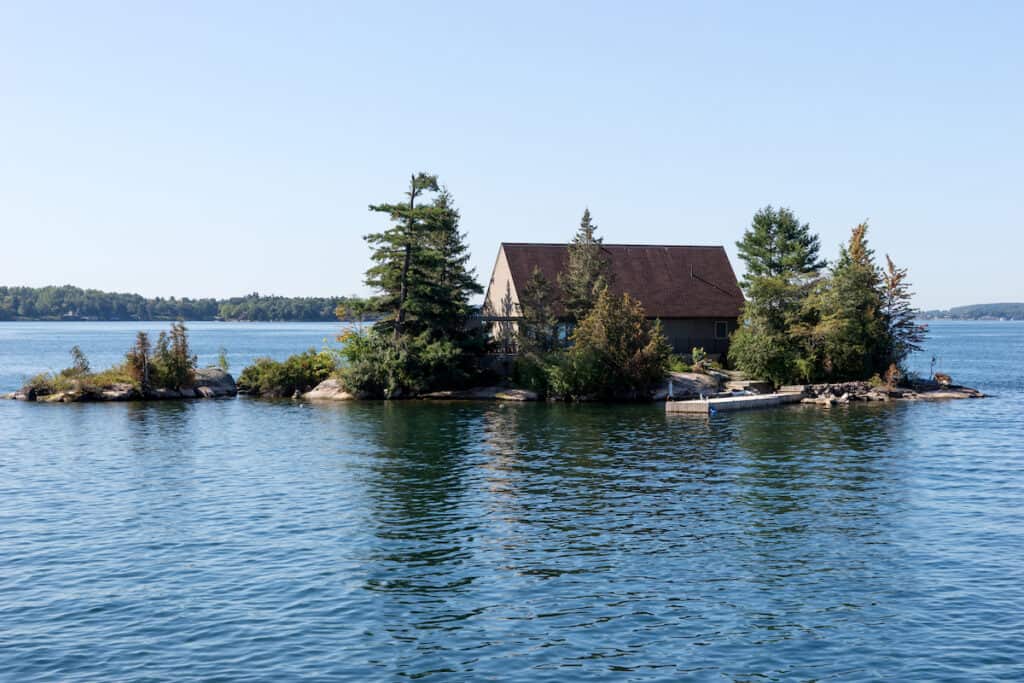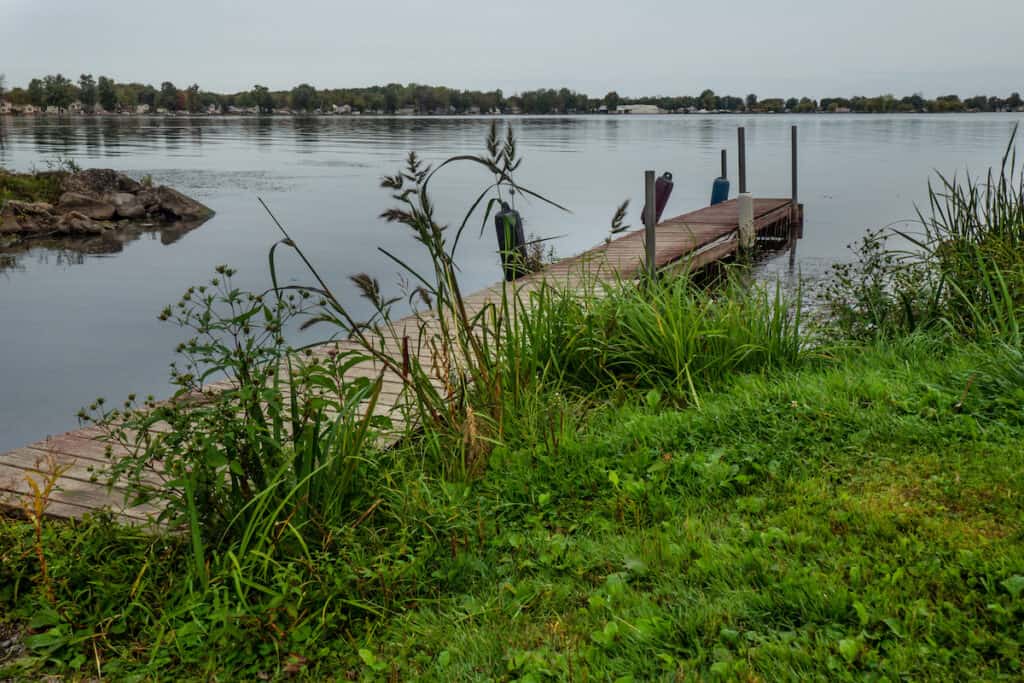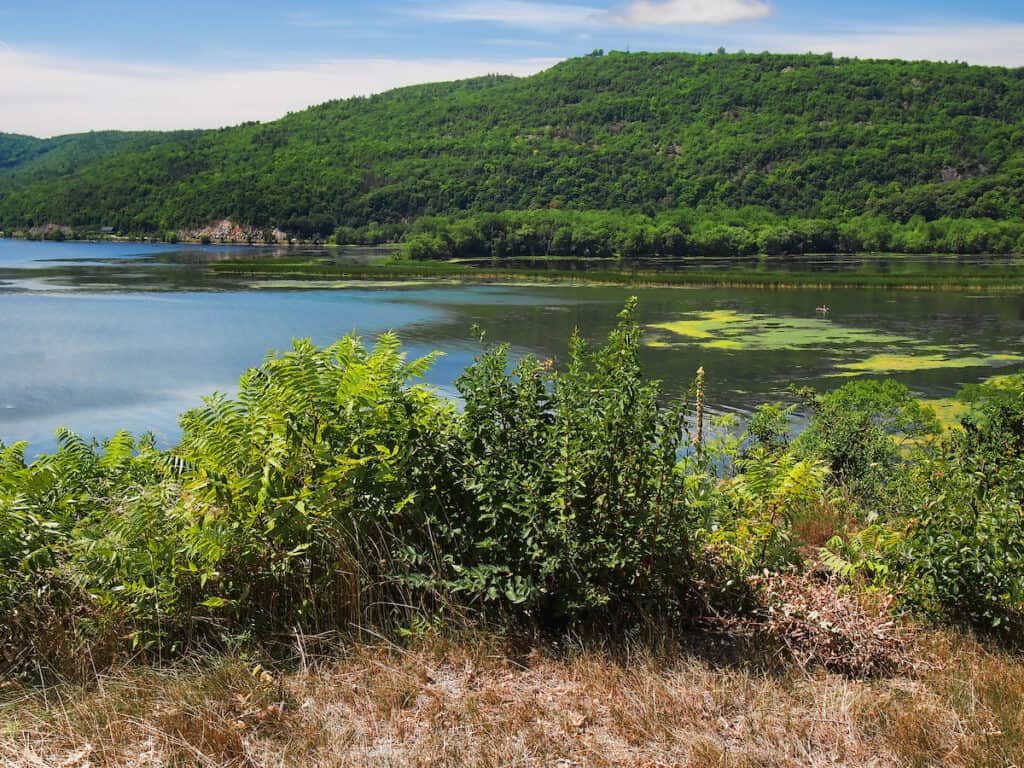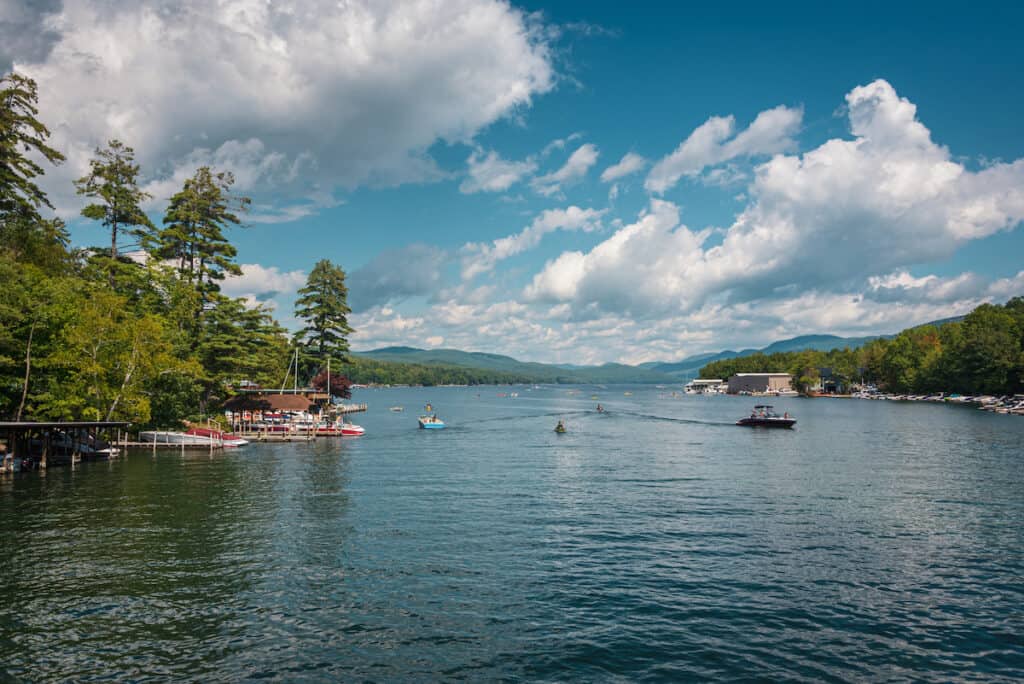New York gets a lot of credit for its great smallmouth bass fishing, and rightly so. But largemouth bass deserve their place at the table too.
Largemouths actually outnumber smallmouths in many New York lakes and are also capable of getting quite a bit bigger.
A largemouth over 6 pounds is considered a trophy fish in New York. You have a fair shot at catching one over that mark in many of the lakes listed below.
The period from May through July is arguably the best season for largemouth fishing in New York. That being said, largemouth bass are caught throughout the warmer months.
Largemouths favor weedy habitats, and as New York’s waters are warming up in spring around the annual spawn, they’re often caught in just a few feet of water.
In summer, they’re most likely to be found in the shallows in the morning and evening. During midday, they usually retreat to deeper drop-offs and weed lines, or bury themselves deep in weedy cover.
Fall fishing can be great, as largemouths often feed voraciously in anticipation of the chilly months ahead. They’re even caught through the ice in winter, though few ice fishermen target them specifically.
The official fishing season for both largemouth and smallmouth bass begins on the third Saturday in June in New York, and ends on the last day of November.
In most lakes, largemouths spawn between late May and mid-June. A special catch-and-release-only season extends from Dec. 1 to the Friday before the third Saturday in June.
Best Largemouth Bass Fishing
The following are New York’s very best lakes and river systems to catch largemouth bass.
Cayuga Lake
Each of the eleven lakes that make up New York’s Finger Lakes supports largemouth bass. But Cayuga Lake—the second-largest Finger Lake at 42,956 acres—is almost certainly the best largemouth lake in the chain.
Like most of the Finger Lakes, Cayuga is long, narrow, and surprisingly deep. Throughout much of the lake, the bottom drops off quickly to a max depth of 435 feet.
Those deep waters support excellent coldwater trout fishing, as well as salmon. But the north end of Cayuga Lake features an extensive area of weedy shallows that encompasses about 5,800 acres. This is where largemouths are right at home.
Depths in this northern part of the lake are seldom greater than 15 feet.
Healthy weed beds there support a wealth of prey fish including alewives, rainbow smelt, gizzard shad and yellow perch. Bass grow fat on the abundant forage, and the vegetation gives them ample habitat.
Cayuga Lake gives up plenty of 5-pound-plus largemouths, and fish in the 2- to 3-pound range are common.
Department of Environmental Conservation (DEC) surveys suggest that largemouths are not especially abundant across the entire lake, but appear to be so because they inhabit such specific areas in great numbers.
During the spring pre-spawn period from late April to late May, largemouths will gradually transition from deeper ledges into this shallow area at the north end of the lake. Lipless crankbaits are great this time of year.
As bass start spending more and more time in shallow water, soft plastics become more useful.
Bass spawn in shallow areas throughout northern Cayuga Lake, and when the spawn starts wrapping up in June, they go into full-on post-spawn feeding mode.
Harris Park, in the village of Cayuga, offers great bank fishing access and a kayak launch. Across the lake, developed launch facilities and a campground are available at Cayuga Lake State Park.
More: Complete Guide to Cayuga Lake Fishing
Thousand Islands (St. Lawrence River)
The Thousand Islands region is an archipelago of 1,864 islands that encompass a vast area in the St. Lawrence River and the easternmost end of Lake Ontario. It’s not hyperbole to call this place a genuine angler’s paradise.
But the Thousand Islands are so well-known for smallmouth bass, walleye, northern pike and muskie that it’s easy to overlook the fact that there’s also stellar largemouth fishing here.
The best largemouth action tends to be in bays and backwaters rather than in the main river.
Goose Bay, which is accessible via Kring Point State Park just outside Alexandria Bay, is a particularly noteworthy largemouth haunt. Chippewa Bay is also great.
The area around Wellesley Island is also a favorite largemouth area. Lake of the Isles—essentially a large bay that’s mostly surrounded by the U-shaped Wellesley Island—may offer the best largemouth fishing in the region.
It’s worth noting that bass in the Thousand Islands may follow any number of patterns. Largemouths often behave like smallmouths here, gathering around rocky ledges and points, especially in areas where a bit of current funnels baitfish through.
But with so many options to choose from, it’s usually not too hard to find a productive pattern on any given day. Start by confining yourself to one of the specific areas mentioned above to keep yourself from getting overwhelmed by the options.
Jigs and drop shot-rigged soft plastics are great lures for finding bass close to structure. Wacky worms and spinnerbaits are great for exploring shallower, weedier areas.
Bass dine on a pretty diverse diet in the St. Lawrence River. But like everywhere else in the Great Lakes system, round gobies have proliferated in recent years, establishing themself as a key prey species for most gamefish, bass included.
Goby-imitating baits fished close to the bottom are almost always effective.
A green pumpkin-colored tube jig is a pretty good goby lookalike, and you’ll find local bait shops well-stocked with lures specifically designed to mimic these small bottom-dwellers.
More: Complete Guide to Fishing the St. Lawrence River and Thousand Islands
Black Lake
A long, narrow glacial lake in the far-flung north country of St. Lawrence County, Black Lake is one of New York’s most consistent warm water fisheries. It’s an absolute bass factory, with tremendous populations of largemouth and smallmouth bass.
Largemouths are perhaps the slightly more common species in this 7,593-acre lake. Average Black Lake largemouths tend to weigh around 2 pounds, and more 5-pounders are caught here than just about anywhere else in the state.
A special regulation on Black Lake ensures that all bass under 15 inches are returned to the water, which helps keep more and bigger bass in the lake.
Black Lake is highly fertile, with an abundance of weed beds as well as sand bars, rocky ledges, islands, and drop-offs that provide prime bass habitat.
Most of the lake is also surprisingly shallow. Black Lake is 40 feet deep at its deepest point but averages less than 10 feet.
Anglers can find success targeting both weeds and rocks for largemouths on Black Lake. Rocky areas are more likely to yield a mixture of largemouths and smallmouths.
Best bets for largemouths include weed beds and pockets between the weeds in the lake’s many bays. Rocky shorelines can yield good catches, especially around the lake’s islands.
The best fishing is usually first thing in the morning, especially in summer.
Shore fishing is available just off State Highway 58, which crosses the lake at its narrow midpoint. Bass are commonly caught near the bridge and along the rip-rap banks on either side of it.
Much of Black Lake’s shoreline is undeveloped, but pitching and flipping under boat docks can be a good early morning tactic on developed stretches of the shoreline.
As the sun gets higher in the sky, focus on deeper weed lines that offer bass shade and cover.
There’s a state boat launch site on County Route 6 on the west side of the lake, and a public fishing and kayak launch site on Rollaway Bay toward the southeast corner of the lake.
While you’re at Black Lake to catch bass, also take advantage of some of the best catfish fishing in New York.
Chautauqua Lake
Located a little over an hour away from Buffalo in Western New York, Chautauqua Lake is a large natural lake that occupies 13,156 acres and offers some very compelling bass fishing options.
For newcomers, it might be helpful to think of Chautauqua as two lakes in one. It has two large basins (north and south) divided by Bemus Point, which creates a narrow bottleneck of sorts near the lake’s midpoint.
Although the two basins are similar in size, they’re very different. Broadly speaking, the northern basin is deep and rocky, while the southern basin is shallow and weedy.
Largemouth anglers, unsurprisingly, tend to make a beeline straight for the southern basin. With its ample weed growth, it’s the kind of area where largemouths are very comfortable. There’s great fishing here as soon as the water starts to warm up in spring.
In late April, it often only takes one good, warm and sunny day to get bass moving. They’ll seek out the warmest water they can find this time of the year, which often means just a foot or two of water in Chautauqua Lake’s southern basin.
Chautauqua Lake’s shoreline is very developed, and casting around docks is a great tactic for pre-spawn largemouths. Soft plastics including stickbaits, tube jigs, worms and creature baits often draw bass out from under docks.
The warmer the lake gets, the thicker the weeds get in the southern basin.
The best summer tactics are fishing topwaters early in the morning or late in the evening, and using soft plastics with heavy weights to punch through the grass when the sun climbs higher.
Chautauqua is, for the most part, a numbers lake. You can expect to catch dozens of bass weighing a pound or two, but there are also a few big, chunky largemouths weighing 5 pounds.
There also are some even bigger predators in Chautauqua Lake, as it is among the best muskie fishing lakes in New York.
The DEC operates a public boat launch at Bemus Point. A little farther up the lakeshore, Long Point State Park is a popular spot to camp, swim, hike, launch a boat or fish from shore.
More: Complete Guide to Chautauqua Lake Fishing
Sodus Bay (Lake Ontario)
The New York shoreline of Lake Ontario is pockmarked with more than a dozen bays, ranging in size from a couple of hundred acres to several thousand. Sodus Bay, located about halfway between Rochester and Oswego, is arguably the best for bass fishing.
Unlike the main body of Lake Ontario, in which smallmouths are the more abundant black bass species, Sodus Bay is dominated by largemouths.
Sodus Bay spans 3,357 acres and is just shy of 50 feet deep. The majority of the bay is shallow, and a variety of submerged, floating, and emergent aquatic vegetation thrive here, covering over 35 percent of the bay’s surface in summer.
The weeds get so thick that the county sends out mechanical harvesters to thin the growth in summer, but largemouth bass thrive in this underwater jungle. There’s excellent bass fishing in Sodus Bay from spring straight through to fall.
The best tactic on Sodus Bay is to simply follow the weed lines.
When the weather is cooperative, you can pick off bass in nearly every pocket among the weeds. Most weigh around 1.5 to 2 pounds, but bass up to 6 pounds have been pulled from the slop.
Thornton Point and Nicholas Point are often productive spots in Sodus Bay, and there’s great bass structure around the bay’s three major islands. The thickest weed growth is toward the southern end of the bay.
Throughout summer, anglers use wacky worms, Ned rigs, and creature baits to ply weedy areas, and a topwater is always worth a try right around daybreak.
When the sun is high, bass seek shade, and you can catch quite a few by targeting docks. The docks that reach out into deep water are best.
The main launch site on Sodus Bay is the state-owned boat ramp on State Route 14. Shore access is limited, but kayak fishing is a great way to get to some of the bay’s more secluded spots.
Sodus Bay has a variety of fisheries, including some of New York’s best yellow perch fishing.
Oneida Lake
The largest lake that lies entirely within New York State, Oneida Lake is a huge 50,894-acre natural lake, located a short drive from Syracuse in Central New York. It’s a truly great multi-species fishery.
Oneida Lake is probably best known as one of New York’s best walleye spots, but when the water warms up in late spring and early summer, many local anglers turn their attention to bass.
Largemouths and smallmouths are both abundant, and the lake has become a bass tournament staple.
Oneida Lake has a huge network of large mid-lake shoals, where you can often catch both species on back-to-back casts. But if you’re specifically targeting largemouths, it often pays to hone in on the shallows.
Large bays that support ample weed growth offer the best largemouth fishing on Oneida Lake. The shoreline is essentially a series of bays lined up one after another, and most of them hold largemouths in good numbers.
Big Bay, located at the northwest corner of the lake is probably the best-known largemouth area, but don’t skip other hot spots like Three Mile, Lower South and Billington bays. In general, the best largemouth action is in the west half of the lake.
The best time to be here is right around the official season opener in late June. By this time, largemouths will have finished spawning, but are usually still active in just a few feet of water, especially in the morning.
Two- to 3-pound largemouths are common.
Target weed lines, especially where the edge of a weed bed intersects with a major depth change.
Docks are often key cover for largemouths too. Look for clusters of docks with weed beds nearby.
Oneida is also a great fall bass lake. Largemouths feed heavily on small perch and gizzard shad this time of year, and are often fooled by swimbaits and spinnerbaits that mimic their favorite forage.
Some anglers also pick off a few bass while ice fishing at Oneida Lake.
Oneida Shores County Park and the state-owned Toad Harbor Fishing Access Site are great places to start fishing from shore, and numerous boat ramps are available around the lake.
More: Complete Guide to Oneida Lake Fishing
Honorable Mentions
New York has plenty more great largemouth waters, including some great numbers lakes as well as a few potential trophy fisheries. Don’t miss out on these honorable mention bass lakes in New York.
Lake Champlain
Lake Champlain is truly massive. Aside from the Great Lakes, this 314,000-acre beast is the third-largest freshwater natural lake in the lower 48 states.
Lake Champlain supports a diverse fishery that includes both largemouth and smallmouth bass, as well as lake trout, landlocked salmon, and panfish including crappie.
Straddling the border between New York and Vermont, Lake Champlain stretches 120 miles end-to-end. As is the case on most lakes, largemouth bass tend to favor Champlain’s weedy bays while smallmouths prefer rocky drop-offs and reefs.
But these are not firm rules. You’re likely to catch a few of each species on many prime spots.
On the New York side, some of the best largemouth fishing is toward the north end of the lake, especially in Catfish Bay and Kings Bay, the latter of which is located at the mouth of the Great Chazy River.
That said, there’s also great bass water toward the narrow south end of Lake Champlain around Ticonderoga. This lake simply offers an abundance of great bass water, and it’s a lot of fun to fish and explore.
To cover water quickly, tie on a jerkbait or willow-leaf spinnerbait to imitate the lake’s ample alewife population. A wacky-rigged Senko or plastic worm is usually a good choice when fish demand a slower presentation.
The South Bay Pier is one of the best spots for shore anglers toward the south end of the lake, and there’s a state-operated boat ramp nearby. Point Au Roche State Park is a great spot farther north.
More: Complete Guide to Lake Champlain Fishing
Conesus Lake
The westernmost of the eleven Finger Lakes and one of the smaller lakes in the chain, 3,420-acre Conesus Lake is easy to ignore. But it’s an outstanding warm water fishery that supports a tremendous largemouth bass population.
The shoreline of Conesus Lake is lined with houses, and dock fishing is a consistent pattern in springtime. Expect to catch a lot of ‘keeper’ bass in the 12- to 16-inch range, as well as the occasional brute measuring 20-plus inches and weighing over 5 pounds.
The perimeter of the lake is mostly a shallow flat between 5 and 10 feet deep, which drops off steeply to 40 feet or more in places. There’s an extended shallow area at the north end of the lake that is very productive.
Vitale Park, which overlooks the north end of the lake in the community of Lakeville, is an outstanding spot for shore fishing, especially from May through early July, when largemouths are commonly caught in less than 5 feet of water.
As weeds gradually take over the shallows in early summer, focus your efforts more on deep weed edges and the first major drop-off. A public boat launch is located on the eastern shore of the lake.
Lake George
Lake George is a huge lake, encompassing 28,451 acres in the foothills of the Adirondack Mountains. It supports a diverse two-story fishery that includes both warm and coldwater game fish.
When it comes to bass fishing, smallmouths are a bit more common than largemouths in Lake George, but there are ample opportunities to target both. That being said, they frequently share habitat here, so expect a mixed bag.
The best time to find largemouths in shallow water is late spring and fall. Target bays with ample weedy cover like Bolton Bay, Basin Bay and Boon Bay along the southwestern shore of the lake. Largemouths spawn in these areas in early June.
In summer, fishing shallow water tends to yield only smaller bass. Work drop-offs and ledges adjacent to shallow weed habitat in 20 to 30 feet of water to get into the bigger fish.
There’s also some great fishing in the area of the lake known as the Narrows, where you can cast around the shores of numerous islands, many of which have boat-in campsites on them.
The area around Rogers Rock at the north end of Lake George is also productive.
More: Complete Guide to Lake George Fishing
North Sandy Pond
Spanning 2,400 acres, North Sandy Pond is a ‘pond’ in name only. Connected to Lake Ontario by a channel and separated from the lake by a unique strip of barrier beaches, it’s really more like a bay.
Fishing for largemouth bass fishing here is excellent, and North Sandy Pond often hosts bass tournaments. With a maximum depth of just 13 feet, the pond supports abundant weed growth and prey fish populations.
Those weeds can become a bit of a nuisance once the dog days of summer roll around, but you can still bust some big bass on topwater poppers, frogs and spinnerbaits.
The best time to fish North Sandy Pond is late spring into early summer when bass finish spawning and feed aggressively along the weed lines. Soft plastic worms, creature baits and weedless jigs are effective.
Neighboring South Sandy Pond is smaller but deeper, and also supports a solid bass population. Both ponds are accessible through Sandy Island Beach State Park.
Pike are abundant in the ponds too, so don’t be shocked if a feisty northern smacks your lure.
Honeoye Lake
Honeoye Lake is one of the smallest and shallowest of the Finger Lakes. Although it spans just 1,772 acres and is only 30 feet deep, it’s an incredible warm water fishery that supports largemouth bass, crappie, chain pickerel, and walleye.
DEC surveys of Honeoye Lakes have turned up some of the highest bass numbers in New York, and catch rates are consistently high. That being said, there aren’t a lot of really big bass here.
Bass over 18 inches are a bit of a rarity, but Honeoye Lake is a great place to catch 12- to 16-inch largemouths until your arms are sore. It’s also a great place to take kids fishing, and the lake’s manageable size makes it ideal for kayaks and other small craft.
Honeoye Lake supports plenty of weed growth, and anglers usually find success by targeting weed edges. Dock fishing is good too, especially first thing in the morning. A public boat ramp is located at the lake’s southernmost point.
Soft plastics are often the most productive lures on Honeoye Lake.
Soft jerkbaits like Zoom Flukes do a good job imitating the alewives that bass are accustomed to eating. A wacky worm falling slowly through the water column often does the trick when bass get tight-lipped.
Catch More NY Bass
As good as the largemouth bass fishing can be here, New York is rightfully more famous when it comes to smallmouth. We have a guide to help you find the best smallmouth bass fishing in New York.
Also, check out our simple how-to fishing techniques and tips for catching more bass.

